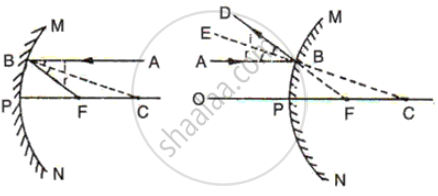Advertisements
Advertisements
Question
Solution

< i = < r
But < ABC = alternate< BCF
Therefore< CBF = < BCF
And the ΔFBC is isosceles
BF = FC ... (i)
PF = FC
PF + PF= PF + FC 2PF = PC
Now since PF = f, the focal length of the mirror
And PC = R, the radius of curvature of the mirror
From here we can determine the focal length of the concave mirror i.e. half of radius of curvature
APPEARS IN
RELATED QUESTIONS
Define the following term in the context of spherical mirrors:- Principal focus
The shiny outer surface of a hollow sphere of aluminium of radius 50 cm is to be used as a mirror:
State whether this spherical mirror will diverge or converge light rays.
A ray of light travels from a denser medium to a rarer medium. How will it bend?
A straight stick partly dipped in water obliquely, appears to be bent at the surface of water.
Define the following term in relation to concave mirror.
Pole
What do you understand by the term real image?
A concave mirror can be used to produce a parallel beam of light. Draw a ray to illustrate this.
An object 10 cm high is placed at a distance of 20 cm in front of a spherical mirror of focal length 25 cm. By scale drawing find the nature, position, and magnification of the image in the following case:
Convex mirror
A shopkeeper wanted to fix a mirror that will give a maximum view of his shop. What type of mirror should he use? Give reason.
